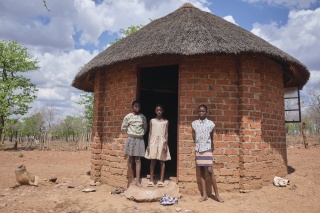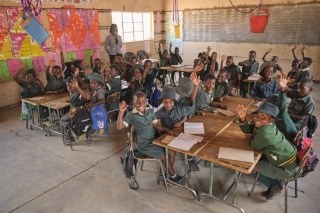
A child’s fight for a poverty-free future in Zimbabwe
Despite the failed rainy seasons and drought, Mary’s Meals is providing Thabita hope for the future.
Published onEach morning, Thabita’s mum, Labhelani, watches her 10-year-old daughter leave their house and begin the 45-minute walk to school. The landscape is stony; it hasn’t rained properly for a few years, and Thabita cuts a small figure as she wanders across the dry ground.
Thabita suffers from epilepsy, and the thought that she could experience a fit on the way to or from school is almost too much for Labhelani to bear. If Thabita is hungry, the risk of her suffering a seizure increases, and the reality is that she frequently leaves home without much in her stomach at all. If there is food at home, it’s normally sadza (a firm porridge with little nutritional value).
Drought is driving food insecurity in Zimbabwe
Following years of failed rainy seasons and drought caused in part by the El Niño weather phenomenon, Zimbabwe – the former “breadbasket” of Southern Africa – is now a country where parents, farmers and elders look to the skies for rain that does not come.
The Zimbabwean government declared a “national disaster” in April 2024 because of the drought, as parched conditions wreaked havoc on the country’s food production and families’ ability to eat. Last year, Zimbabwe’s maize harvest was around 60% lower than its 10-year average for maize production, and estimates show that around six million people (more than 35% of the population) will be food insecure during the early part of 2025. Children and their futures are also hanging in the balance, as more than a fifth are not attending school.
Climate shocks that have caused major issues with overall food production in recent years have come alongside economic instability in Zimbabwe, compounding the day-to-day difficulties faced by subsistence farmers and low-income households. Many basic commodities are now unaffordable for most families.

Mary’s Meals provides a lifeline for children and their families
Thabita’s parents work “informally” in gold mining. If they find small flakes of gold, they can sell it to feed their five children. If they don’t, they have no money to put food on the table. Labhelani is worried that 2025 may be even more challenging than the year just passed.
Thabita remains determined to go to school, and there is a particular incentive for her excellent attendance. Every school day, she and her fellow pupils at Sijauke Primary School receive a hot mug of nutritious porridge provided by Mary’s Meals. The porridge is enriched with the vitamins and nutrients that children need to grow and to learn, and prepared and served by Mary’s Meals volunteers from Thabita’s community. In this turbulent environment, Mary’s Meals is a lifeline for young learners and their families.
“The porridge has helped Thabita with her education,” says Labhelani. “She’s motivated to go to school because of how much she loves the porridge. I am keen that she keeps attending school because I know that education can give someone a future.”
Consistent, nutritious meals give Thabita the energy to make the most of her time at school. She says: “I love the porridge because it is delicious. It fills my tummy and then I can read and write better. I am motivated to come to school because I want to pass. I want to go to secondary school and then start working so that I can stay in my own house.”

Hope of a brighter future
Labhelani’s dream for her daughter is something most parents can identify with. She simply says: “I wish for a bright future for my child.”
Our school feeding programme – made possible through the hardworking volunteers in the local community and generous support from our supporters – is helping Thabita move one step closer to that.
It costs just £19.15, €22, $25.20 USD or $31.70 CAD to provide a child with school meals for an entire school year. Mary’s Meals is currently serving nutritious daily meals to more than 1.5 million children in schools across Southern Africa. Now, more than ever, your support is needed to spread the word about our work and the emergency in the region. With your support, we can reach many thousands more children waiting for our daily meals.
This story first appeared in My Weekly magazine in January 2025.
Gary Armstrong is our Media Manager for Mary’s Meals UK. He recently travelled to Zimbabwe, where he spent time with children at schools in which Mary’s Meals are served.
